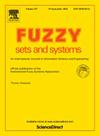概率环境中的不确定性与基本不确定性信息的融合
IF 3.2
1区 数学
Q2 COMPUTER SCIENCE, THEORY & METHODS
引用次数: 0
摘要
基本不确定信息是最近引入的一种重要的不确定类型,在具有内在不确定性的决策环境中证明特别有价值。在本研究中,我们提出了不确定性认知合并的概念,它能有效地将基本不确定信息颗粒与概率度量相结合,从而在同一概率空间内生成新的概率度量。此外,我们还提出了一种退化方法,将基本不确定信息颗粒与单位区间合并,以创建新的子区间。我们介绍了四种不同的不确定性认知合并方法,并深入比较和分析了它们各自的特性、局限性和优势。为了展示我们建议的实际应用潜力,我们在提供进一步数学结果的同时,还提供了数值示例。本文章由计算机程序翻译,如有差异,请以英文原文为准。
Uncertainty merging with basic uncertain information in probability environment
Basic uncertain information is a recently introduced and significant type of uncertainty that proves particularly valuable in decision-making environments with inherent uncertainties. In this study, we propose the concept of uncertainty cognition merging, which effectively combines basic uncertain information granules with probability measures to generate new probability measures within the same probability space. Additionally, we present a degenerated method that merges basic uncertain information granules with unit intervals to create new subintervals. We introduce four distinct uncertainty cognition merging methods and thoroughly compare and analyze their respective properties, limitations, and advantages. To demonstrate the practical application potential of our proposals, we provide numerical examples alongside further mathematical results.
求助全文
通过发布文献求助,成功后即可免费获取论文全文。
去求助
来源期刊

Fuzzy Sets and Systems
数学-计算机:理论方法
CiteScore
6.50
自引率
17.90%
发文量
321
审稿时长
6.1 months
期刊介绍:
Since its launching in 1978, the journal Fuzzy Sets and Systems has been devoted to the international advancement of the theory and application of fuzzy sets and systems. The theory of fuzzy sets now encompasses a well organized corpus of basic notions including (and not restricted to) aggregation operations, a generalized theory of relations, specific measures of information content, a calculus of fuzzy numbers. Fuzzy sets are also the cornerstone of a non-additive uncertainty theory, namely possibility theory, and of a versatile tool for both linguistic and numerical modeling: fuzzy rule-based systems. Numerous works now combine fuzzy concepts with other scientific disciplines as well as modern technologies.
In mathematics fuzzy sets have triggered new research topics in connection with category theory, topology, algebra, analysis. Fuzzy sets are also part of a recent trend in the study of generalized measures and integrals, and are combined with statistical methods. Furthermore, fuzzy sets have strong logical underpinnings in the tradition of many-valued logics.
 求助内容:
求助内容: 应助结果提醒方式:
应助结果提醒方式:


